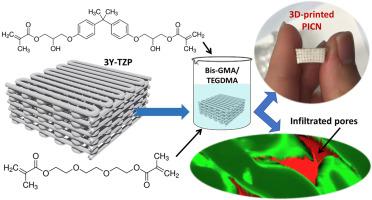Additive Manufacturing ( IF 10.3 ) Pub Date : 2021-01-15 , DOI: 10.1016/j.addma.2021.101850 L'udmila Hodásová , Jordi Sans , Brenda G. Molina , Carlos Alemán , Luis Llanes , Gemma Fargas , Elaine Armelin

|
Herein, for the first time is described the design of a novel porous zirconia scaffolds manufactured by using polymer-infiltrated ceramic network (PICN) and 3D-printing technologies. Cubic geometry of pieces was obtained by perpendicular layer-by-layer deposition of yttrium-stabilized tetragonal zirconia polycrystal (3Y-TZP) and Pluronic® hydrogel ceramic paste. The specimens were prepared by robocasting assembly with 50% infill and 50% of pores, as feed setup. Bisphenol A glycerolate dimethacrylate (Bis-GMA) and tri(ethylenglycol) dimethacrylate (TEGDMA) copolymer, a well-known biocompatible adhesive, which is widely used in dentistry field, was employed to reinforce the pores of the 3D-printed ceramic structure. The success of the acrylate polymer infiltration above the scaffold surface and among the 3Y-TZP filaments was achieved through previous ceramic functionalization with 3-(trimethoxysilyl)propyl methacrylate (γ-MPS). The well infiltration of the material on pores was evaluated by gravimetry, obtaining a value of 87.5 ± 6.6% of pores covered by the adhesive. Such successful infiltration of methacrylate copolymer had also a positive effect on the mechanical properties of the scaffold material, being the PICN sample that one with the highest elongation resistance. The new system showed reduced bacteria proliferation, over 24 h of incubation with Gram-negative Escherichia coli and Gram-positive Streptococcus salivarius bacteria lines, when compared to the control.
中文翻译:

具有生物相容性粘合剂和3D打印的高度多孔支架的聚合物渗透陶瓷网络
在此,首次描述了通过使用聚合物渗透陶瓷网络(PICN)和3D打印技术制造的新型多孔氧化锆支架的设计。通过垂直地逐层沉积钇稳定的四方氧化锆多晶体(3Y-TZP)和水凝胶陶瓷浆料获得立方几何形状。通过机械浇铸组装样品,进料设置为50%的填充物和50%的孔。双酚A甘油二酸酯二甲基丙烯酸酯(Bis-GMA)和三(乙二醇)二甲基丙烯酸酯(TEGDMA)共聚物是一种广泛使用于牙科领域的众所周知的生物相容性粘合剂,用于增强3D打印陶瓷结构的孔隙。通过先前用甲基丙烯酸3-(三甲氧基甲硅烷基)丙酯(γ-MPS)进行的陶瓷官能化,成功地使丙烯酸酯聚合物渗透到支架表面上方以及3Y-TZP长丝中。通过重量分析法评估了材料在孔中的渗透性,得出粘合剂覆盖的孔值为87.5±6.6%。甲基丙烯酸酯共聚物的这种成功渗透也对脚手架材料的机械性能产生积极影响,因为PICN样品具有最高的抗伸长性。新系统在革兰氏阴性菌孵育24小时后显示出细菌繁殖减少 6%的孔被粘合剂覆盖。甲基丙烯酸酯共聚物的这种成功渗透也对脚手架材料的机械性能产生积极影响,因为PICN样品具有最高的抗伸长性。新系统在革兰氏阴性菌孵育24小时后显示出细菌繁殖减少 6%的孔被粘合剂覆盖。甲基丙烯酸酯共聚物的这种成功渗透也对脚手架材料的机械性能产生积极影响,因为PICN样品具有最高的抗伸长性。新系统在革兰氏阴性菌孵育24小时后显示出细菌繁殖减少与对照相比,大肠杆菌和唾液革兰氏阳性链球菌细菌系。










































 京公网安备 11010802027423号
京公网安备 11010802027423号